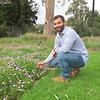Most of us can attest to the fact that being outdoors feels rejuvenating and it turns out science actually backs that up. Research has shown that three to five minutes of looking at trees, flowers or water can induce a relaxation response and reduce anger, anxiety and pain, and a study of hospital patients found those who had a bed that looked out of windows towards leafy trees had shorter hospital stays and required less pain medication than those staring at blank walls.
While any garden is a 'good' garden, Charles Solomon, who specialises in native Australian botany, land management, conservation and ecosystems, says that using Aboriginal knowledge when planting a garden can enhance its healing power. "As a kid, my Pop used to take me out in the bush and teach me about all of the different plants and their different uses," he tells SBS Life. "I learnt to respect the plants and how they can help us in all different types of ways – mentally, physically and spiritually."
How to create your own healing garden
Enhance the local ecosystem
Not only will native plants thrive in your local climate, but you'll likely get some special visitors as well. "You are creating a natural, mini ecosystem in your front or backyard," Solomon explains. "If you are planting rare, local plants that are endangered and putting them in your garden, you'll attract native birds that will spread the seed."
Plant sporadically
Unlike English gardens that are typically planted in neat rows, Solomon says a native Australian garden should be more ad hoc. "Try to mimic the native ecosystems that you see out in the bush," he suggests. And don't fret that a native garden will be all green. "There are so many different local wildflowers – your options are endless with what you can do with plants native to your local area," Solomon says.
Ask local elders for knowledge
Contact your local council to see if there are some local Indigenous organisations or elders who can help you understand the plants native to your area. "In Melbourne you could start at the Koori Heritage Trust at Federation Square or the Melbourne Museum," Solomon explains. "People need to think about where they are located and what used to be there a couple of centuries ago."
Grow your own bush medicine
Solomon says one of the first things he would always plant in a backyard is a tea tree. "It's from the same family as eucalyptus and has that strong scent in the leaves," he says. "You can make your own tea tree oil from the leaves and use it as an antiseptic."
Drink to good health
Bushy coastal banksia flowers can do more than bring colour to a garden. "With some types of banksia you can break off the flower and mix it with water – it's like cordial and sweetens the water," Solomon explains. You can also use lemon myrtle leaves to make a healthy tea. "It tastes beautiful and I'm sure it's good for you," Solomon says.
Get crafty
Lomandra longifolia (basket grass) is Solomon's other must-have – it grows easily all over Australia and can be used for craft and hydration. "The grass was traditionally used for basket weaving, which is an awesome pastime for all of us to engage in," he points out. "You can also chew on the white ends and it releases juice that tastes just like snow peas. Aboriginal people would use it on hot days to keep their mouth nice and wet."
Tell a story
For centuries Aboriginal people have used native plants to tell dreamtime stories, and Solomon loves using local stories to make great garden designs. Just recently he has been in Canberra working on a garden at the National Arboretum celebrating Mununja, the butterfly. "We worked closely with the local Ngunawal elders to make sure all of the plants in the garden are medicinal or can be used for food or to make tools, and also attract butterflies," Solomon explains. "You could speak to elders in your local area and use your garden to tell an important story."
Love the story? Follow the author here: Twitter @kimberly_writes Instagram @kimberlygillan.
First Contact (season 2) airs on 29 November, 30 November and 1 December 2016 at 8:30pm on SBS. Across 28 Days, six well-known Aussies take an epic journey into Aboriginal Australia. Watch the trailer here, and catch-up on episodes after the program airs via SBS On Demand here.

